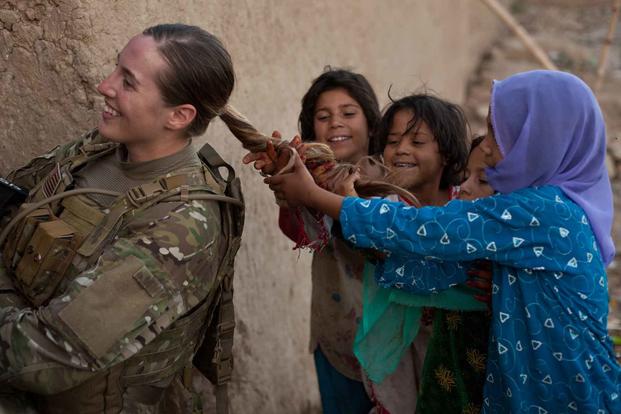Cpt. Kelsey Boursinos just arrived in Hawaii to serve with the 25th Infantry Division in September, but before she could settle into her new assignment, she quickly found herself at the center of a controversy regarding her hair.
Two senior enlisted leaders blasted her for having what they saw as unauthorized French braids. The problem: She was in the right and wearing her hair in accordance with new hair policies set for women five months ago.
Military.com spoke with eight women serving in the Army across different units and bases, all of who have similar stories of mostly male senior leaders telling them their hair is out of regulation, or that they disapprove of their hairstyle, despite fresh Army guidance granting women more flexibility with braids, ponytails and highlights.
The Army is at a cultural turning point, as the force, and Defense Department as a whole, aims to make the military a much more inclusive force. For civilians, simply allowing a braid or ponytail might sound inconsequential.
But for women serving, the change in hair policy was largely seen as Army leaders for the first time listening to women, who the force is increasingly reliant on, and breaking away from its tunnel vision of catering to men. The updates were praised by the Army’s rank and file, especially among the some 181,000 women serving on active duty, the Reserve and National Guard.
Boursinos, a signal officer, started wearing her hair with two braids during her time in the Captain’s Career Course at Fort Gordon, Georgia, when the Army updated its uniform and grooming regulations in May.
Read Next: Senator Calls for Massive Investigation into What Went Wrong in Afghanistan
“Not a single time was I asked or questioned about it; that’s why I was so caught off guard,” Boursinos said in an interview with Military.com.
Yet when Boursinos was at a patching ceremony, an event that welcomes new soldiers to the division, a male command sergeant major told her that her braids were unauthorized.
She said the sergeant major told her that her braids had to come together to form a single braid, an incorrect interpretation for the rules that allow women to have two braids. Given Boursinos was familiar with regulations on women’s hair, she was confident she was in the right, but told the sergeant major she would double-check the policy.
Later, a second male command sergeant major was quick to pile on with a false correction.
“There was another sergeant major who was just standing behind me and waiting for me to start walking to my car, and he approached me, introduced himself and told me my hair wasn’t in regulation,” Boursinos said.
“He told me that the reg is clear and black and white and that I needed to set an example. I don’t expect people to know every regulation, but I do expect people to ask if they don’t know or do the research before making the correction,” she said.

The following day, she emailed the two sergeants major and attached the updated policy, noting that her hair was indeed authorized. But the two men dug their heels in, emailing her that they were tracking the policy and that she wasn’t following it.
“Now they're just choosing to ignore it,” she said. She now carries the regulation at all times. “I think it’s an older generation not wanting to conform to change.”
Neither command sergeant major is in Boursinos’ unit, and she says she feels supported by her chain of command. The incident spurred a quick probe from the 25th ID’s inspector general’s office, which concluded the braids were authorized, according to documents reviewed by Military.com. The division’s public affairs also posted the changes for women’s hair to social media in a short campaign to educate the force after the incident, given some of the division’s most senior enlisted leaders seemingly weren’t aware of it.
The way Boursinos sees it, if an officer can catch flak from senior leaders even when she provides the regulation, that is a red flag for how women more junior might be treated in the ranks, and if leaders are going to nitpick policies and be wrong, that raises questions on whether they can handle larger challenges.
“It sounds silly because it’s hair, right? But having the experience I had, I think about someone’s ability to lead. If we’re stuck on someone’s hair, how are we treating people on bigger issues?” she said. “The regulation exists for a reason; we don’t get to pick and choose what we follow. I am worried about how more junior female soldiers are treated.”
Giving women more flexibility
The Army’s new set of long anticipated revisions allowed women to have more comfortable hairstyles that make them more effective in training and combat, and reduce the risk of injuries, migraines, and hairline damage associated with constantly having hair pulled back.
The changes included allowing women to keep their hair in a single ponytail, two braids or a single braid; twists; or cornrows that may come together in one or two braids or a single ponytail. Braids and singular ponytails may be worn down the center of the back in all uniforms. There’s no minimum length, but a ponytail or braid may not extend past the bottom of the shoulder blades while standing at attention. Women can also have highlights in their hair, so long as the highlights are a natural color.
The changes were widely covered in the press, including Military.com, major national papers and cable news, in addition to the Army’s own publicly available press release and multiple social media posts by top leaders.
However, while the text of the rules are clear, a force-wide brief provided to Military.com on the changes did not include a photo of a woman with two braids, but includes photos showing most other adjustments to hair policy.

One Army official who worked on the policy changes told Military.com that one of the prime motivations for updating the hair policy for women was that more flexible hair styles can alleviate chronic tension on the hair and scalp, which can lead to traction alopecia, a hair loss condition caused by hair constantly being pulled. It’s a condition for which veterans can claim disability through the Department of Veterans Affairs.
Another motivator was making women more functional in combat. The previous rules were strict, generally only allowing women to have their hair in a bun, which makes wearing helmets almost impossible. In combat, and training events such as marksmanship, women were already having to ditch having their hair in a bun, and wear their hair in, at the time, unauthorized ponytails or just let their hair down.
“It saves the hairline for one, and the VA money; it helps equipment fit better. All we did is codify what was already happening in [combat] units,” the Army official told Military.com in an interview on the condition of anonymity.
Battle braids
One woman, a non-commissioned officer, or NCO, who spoke to Military.com on the condition of anonymity for fear of retaliation, is currently deployed with an Army unit overseas and keeps her hair in braids, mostly to make it easier to wear a helmet on combat missions and training.
An NCO above her in the chain of command told her that her braids were unauthorized. Being an NCO herself, and the only woman on the mission, she is frustrated that men who have blown off learning the rules for women still feel the need to comment about her hair. She showed the NCO the new policy and said he “didn’t like being corrected” and that he has a history of making women change their hair to conform to a bad interpretation of the rules.
“I have to know all the male regulations, and some senior leaders aren’t taking the time to learn all the female standards,” she said. “There's an intimidation factor. He corrected me in front of my soldiers; he didn’t have to undermine me like that.”
Back in the U.S., before the deployment, she said this NCO made two women dye their hair a flat color despite the rules clearly approving highlights so long as they are natural colors or do not show a “vast difference between shades of natural colors,” such as “natural black hair with blonde highlights,” according to the policy.
“They knew they could have [highlights], but were intimidated,” she said.
A junior soldier who spoke with Military.com on the condition of anonymity to avoid retaliation also said she was told she couldn’t have natural, conservative highlights in her hair, which the new rules allow. She also was told to ditch her ponytail.

“My master sergeant called me out in front of the entire office,” she said. “My hair is really short in a ponytail, I had a chief warrant officer say they didn’t like seeing that in the office.”
Another woman, a corporal in the National Guard, was told her ponytail was “unprofessional” immediately following the new rules and told Military.com she just wore a bun to “not deal with” her platoon sergeant asking her about it. He was recently promoted to a new unit, and she now wears a ponytail without hassle.
But it isn’t exclusively blasting women for changes to grooming standards they either don’t know about or understand.
One of the soldiers said that some of the comments seemed specifically designed to alienate women in the ranks.
“Some push things harder on females than others; it becomes about picking on the female.”
-- Steve Beynon can be reached at Steve.Beynon@military.com. Follow him on Twitter @StevenBeynon.
Related: Army to Allow Long Ponytails in All Uniforms, Top Enlisted Leader Says












